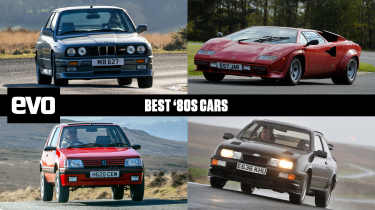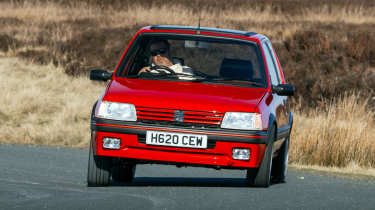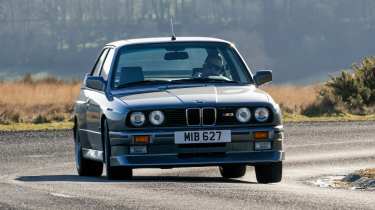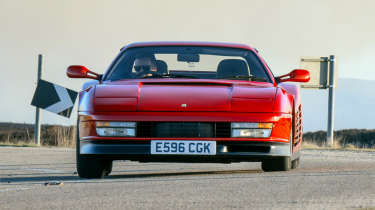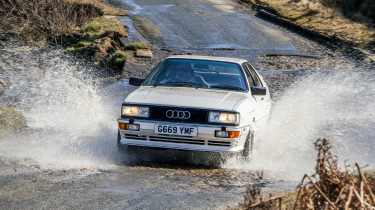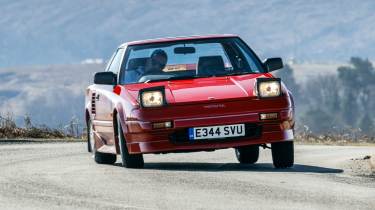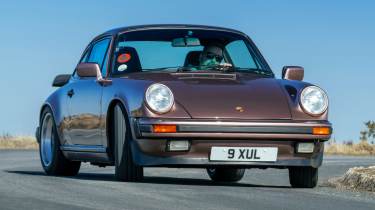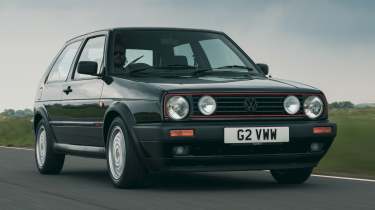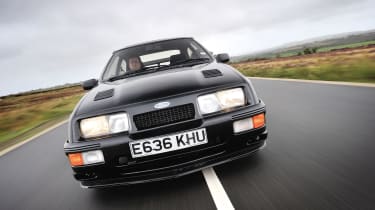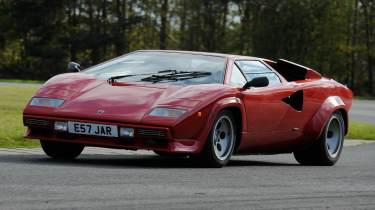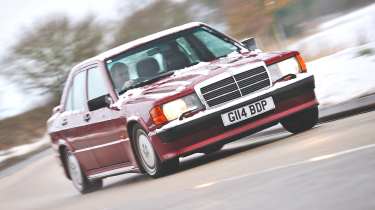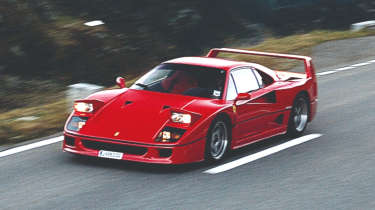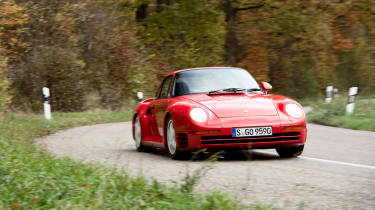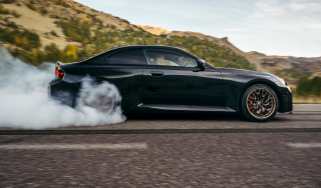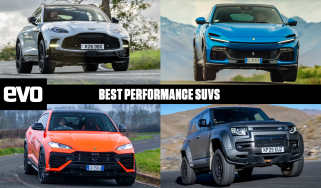Best cars of the 1980s – performance icons from the decade of excess
The performance car as we’ve come to adore it has its origins in the 1980s. Family cars got fast, fast cars got faster, all of them were huge fun
The 1980s saw an explosion of performance car introductions, to the extent that it warranted the birth of a new magazine. That magazine, by the name of Performance Car, was evo’s direct predecessor and was kept plenty busy with an astonishing burgeoning market of performance cars, from Lamborghini, Ferrari and Porsche, all the way down to the surging genres of affordable performance cars, the humble hot hatch and sports saloon.
As Peter Tomalin explained in the introduction of our evo Eras 1980s test: ‘No longer the sole preserve of boy racers, modifiers and amateur mechanics, performance cars had become mainstream and their numbers were growing fast. In fact, UK sales of performance cars had grown by an astonishing 350 per cent between 1980 and ’82 – pretty much every model range had a performance derivative. For sheer breadth of choice it was without doubt a golden era.’
Let’s count down our very favorite, as well as some of the most significant performance cars of the 1980s, including the stars of our evo Eras 1980s test featured in issue 334.
Peugeot 205 GTI (1985 - 1995)
-
Price new: £9930 (1988), £27,098 (Today's money)
-
Value today: £6k-£35k
The Peugeot 205 GTI is almost a well-worn cliche at this point, as a car that set the mold for what a hot hatch should be – quite quick yes but fundamentally, interactive and fun. Arriving first in 1984 with a 1.6, the hot rod that was the 1.9 arrived soon after in 1985. With a 1.9-litre fuel-injected engine, as boasted about with that ‘I’ in the badge, they had between 105bhp in the 1.6 and 130bhp in the 1.9.
The 1.9 could scrabble its way to 62mph in 7.8sec, which though it doesn’t sound quick by today’s standards, is eye-opening in what feels like a four-wheeled tin can. Everything’s so close to you – the huge windscreen and windows, the doors themselves. The pillars are so thin, the glass so tall – you feel like you’re an integral piece of the puzzle, rather than a passenger as in the enormous, hemmed-in cars of today.
That carries into the way the 205 feels to drive. You’re the opposite of insulated from the experience. You can feel the manifestation of every little input in the car’s behaviour and so you learn to fine-tune, for instance, every twist of the steering wheel, less it results in too much of an outward swing from the tail end, or too much roll into ditch-tempting understeer. Building up a flow and generating a dialogue with the 205 isn’t optional, or a happy possibility. It’s a necessity, not just to get the very best out of it, but to avoid getting the very worst out of it…
‘The 205 has that terrier-like quality that infects all the best hatches and would see it snapping at the heels of supposedly sporting coupes and roadsters. Back in the ’80s this would have been an MGB or TR7 driver’s worst nightmare.’ – Peter Tomalin, evo lifer and contributor, who conducted the evo Eras: 1980s test, pitting a 1.9 205 GTI against other titans of the decade.
BMW M3 (E30, 1986 - 1991)
-
Price new: £26,850 (1989), £69,639 (Today’s money)
-
Value today: £100k-£150k
The first M3, the E30 built between 1986 and 1991, was an esoteric one. It wasn’t the 3-series derivative with the largest engine, nor was it the plushest, nor was it the most stylish – that height extension on the boot lid has never not been crude. But for a keen driver, there’s not a lot else out there like it. Its significance and icon status come in part thanks because of what was such a prominent presence in racing as well as on the road. Winning the German, British, Italian, European and World Touring Car Championships, it became one of the great ‘race on Sunday and sell on Monday’ success stories.
Is it an M car as we know them today? Not at all, given it was the first and last M car in sense, where the road car was almost an afterthought – a necessity – to allow the racer to compete. Even the E36 that followed it got a larger engine, more toys and less focus, as it settled into its place as the head of the 3-series range with very little connection to racing variants (the 320i was campaigned in the Super Touring era).
That road racer status works for and against the first M3. Some find the 2.3-litre 200bhp S14 BMW Motorsport four-cylinder engine to be gruff and lack exoticism, even compared to the six-cylindered 3-series models it was sold alongside. Some find it to be lacking in punch. But the M3’s also got that sense of alertness, a lack of slack and a feeling of purpose, that only homologation specials seem to possess. And being from the era that it is, it’s lightweight, compact and shot through with delicious sensory stimuli. It might be a race track refugee, but there’s alacrity and pliancy to the way it graces a road, not crashing into it as some overly still modern performance cars with zero motorsport DNA do. What is racey is the way it wants to be driven – to be really grabbed by the scruff of the neck.
‘It feels drumskin-tight and rattle-free, and it covers the ground beautifully. A little gutless compared with a contemporary Audi Quattro but with a greater sense of poise and control, the steering a touch light but pleasingly precise. Yes, it would be more exciting with more power, but as with so many of the cars of this era it’s not about outright performance, it’s about carrying speed; composure; feeling connected. It’s a precision tool and totally absorbing.’ – Peter Tomalin evo lifer and contributor, who conducted the evo Eras: 1980s test, pitting an E30 M3 against other titans of the decade.
Ferrari Testarossa (1984 – 1991)
-
Price new: £62,666 (1984), £200,068 (Today's money)
-
Value today: £100k-£300k
Gracing many a bedroom wall poster in the 1980s was of course the Ferrari Testarossa. With enough visual madness to at least warrant a second glance next to a Countach, you could be forgiven for assuming it’s every bit the uncompromising supercar typical of the decade of excess. If you’ve driven one, you’ll know that’s not quite true. Named ‘red head’ after the cam covers that look so distinctive on its flat-12 engine, the Testarossa launched in 1984 as a replacement for the aging 512 BBi.
The 4.9-litre engine mounted amid the Testarossa’s tubular steel chassis features fuel injection and is good for 385bhp. That power only fully arrives all the way up at 6300rpm too, which means to extract that performance, you need to run it through the revs and gears. If you don’t fancy exercising your left arm rowing what is a heavy shift hither and twain, that’s not such a great thing. If you love a musical multi-cylinder engine, it’s the best thing in the world. Performance was by today’s standards, not earth shattering, with 0-60mph taking 5.8sec while the Testarossa would, given adequate room, stride along up to 181mph.
The thing that surprises however are its dynamics. It rides well, it rolls, there’s give in the tyres and patience to its behaviour. It doesn’t suffer excess agitation at the limit – the momentum from the weight of that enormous engine aft your shoulders is always in the periphery of your mind – but it does flow with relative benility. There’s all the character of a fizzing, 12-cylinder supercar but with a surprising grand touring acumen. Take the Testarossa for what it is and not what you expect it to be from looking at it and you’ll be surprised and delighted at its usability.
‘It’s physical, but not wearing. A sports car with GT civility and a naturally relaxed, long-striding gait. You never forget its width, but you don’t get the same sensation of sitting at the pointy end of a rocket with an enormous body behind you, as you would in, say, a Diablo. Push on and in tighter turns you can feel a hint of understeer, clearly telegraphed, to let you know you’re getting close to the limits of the relatively modest Michelins. There’s decent brake response and feel – a rarity in this group. Just as well in someone else’s 40-year-old 180mph-plus flat-12 Ferrari.’ – Peter Tomalin evo lifer and contributor, who conducted the evo Eras: 1980s test, pitting the Testarossa against other titans of the decade.
Audi Quattro (1980 - 1991)
-
Price new: £32,995 (1989), £85,577 (Today's money)
-
Value today: £20k-£100k
Without the Quattro, is there Audi as we know it today, let alone Audi Sport? Much the same can be asked of BMW M and the E30 M3 mentioned above. But where the E30 is the most well-known in a family of icons, the Quattro is pretty much Audi’s flag waver for performance cars and the bedrock upon which its RS- and S-badged family of performance cars has been built.
Everyone knows the story of its rallying success, bringing the benefits of four driven wheels with near-miraculous power distribution faculties to roads less driven to devastating effect. But the Quattro as a road car was a thing to enjoy too. First available with switchable locking diffs, the latter 20-valve cars that arrived after the Quattro’s rallying zenith received a torque-sensing centre differential and a four-valve cylinder head on the 2.2-litre 220bhp engine.
Quattros aren’t precise sporting devices to drive like say, a 911 or even the Testarossa and M3 above but they’ve a certainly brutal charm. There’s a satisfaction to using the car’s momentum, the turbocharged mid-range brawn of that engine and the quattro system’s flexibility to point and squirt the Quattro in your chosen direction. That engine is shot through with charm though, especially in cars without catalytic converters.
‘It still feels quick across the ground, with a generous slug of turbocharged torque and the evocative if remote shooshing of the turbo. And when it’s hauling hard through a corner, nose raised, tail hunkered down, it still feels mighty, and simply dripping charisma.’ – Peter Tomalin evo lifer and contributor, who conducted the evo Eras: 1980s test, pitting the Quattro against other titans of the decade.
Toyota MR2 Mk1 (1984 - 1989)
-
Price new: £9295 (1984), £29,675 (Today's money)
-
Value today: £3k-£10k
The Toyota MR2 is a performance car of strange origins, albeit origins that are strangely relevant today. The Midship Runabout Two-seater was a response to the fuel crisis and evidence that enthusiast cars could be fuel-sippingly efficient too. The 4A-GE engine, like the car, is diminutive – just 1.6 litres and 122bhp, albeit with a zinging redline of over 7000rpm thanks to its sixteen valves, multi-point injection system and sophisticated variable intake. That potency was put to effective use in a car that weighs under a ton and sits across a tiny footprint.
Small it might have been but the MR2 boasted supercar-esque styling and expertly-hewn dynamics. One Roger Becker, of Lotus fame, is known to have worked on the MR2 in terms of its driving dynamics, the notorious stickler for damping detail honing Toyota’s two-seat mid-engined sports car long before the Elise was an idea in a notebook. The result is a car that’s composed yet compliant, with a flowing balance not unlike that we enjoy today in the MX-5.
‘The little Toyota feels simply brilliant. The 1.6-litre twin-cam, modelled on Ford’s BDA, is a zingy, free-revving smile-generator. The gearshift is wondrously light and precise, astonishingly so for a cable-operated shift. The unassisted steering, heavy at parking speeds, quickly lightens once you’re on the move and is perfectly geared and flowing with feedback, as is the whole car. It’s the MR2’s chassis, pliant yet poised, that’s the real revelation. There’s a sense of minimal inertia, up-on-its-toes nimbleness, smooth progression. This is a small car touched with greatness, one that’s previously slipped under the radar for a number of us.’ – Peter Tomalin evo lifer and contributor, who conducted the evo Eras: 1980s test, pitting the Quattro against other titans of the decade.
Porsche 911 Carrera 3.2 (1984 - 1989)
-
Price new: £32,849 (1987), £93,141 (Today's money)
-
Value today: £50k-£100k
The 911 permeates almost every generation of performance cars, unless you go as far back as the 1950s when Porsche was finding its feet with the 356. The 1980s were an odd decade for this car – one that demanded innovation but to still stay true to what at the time made a 911 so distinctive. Porsche’s response was to begin with the engine. In the 3.2 Carrera, almost a decade and a half before wholesale water cooling and a fresh chassis in the 996, change was afoot, with the arrival of electronic fuel injection. That and the jump from 3 litres to 3.2 litres informed a rise in power to 231bhp. The basic 911 of the 1980s was therefore a brisk car, with an official 0-60 time of 6.1sec that was spectacularly conservative. The taper-tailed 3.2 would actually gnash at the coat tails of that Testarossa and a Countach in practice.
The dynamics were still overtly 911, though. No power assistance in the steering, still a torsion bar rear end, though better braking came courtesy of discs from the old 911 Turbo. It’s still a physical experience to steer, to shift, to hustle. Why is it one of the best cars of the 1980s? Because it’s for some an ideal melding of old-school 911 charm, with the slow creep of technological influence. One person’s goldilocks 911 is a 997, another’s surely is the 3.2 Carrera.
> Porsche 911 3.2 Carrera review
‘You expect a very physical experience, and boy does it deliver one. Seriously beefy steering, a heavy, slightly long-winded gearshift and weighty pedal actions are seemingly at odds with the Carrera’s petite dimensions but well-matched to its meaty damping and the feeling of robustness that’s shot through the shell. The expanded engine delivers its best work above 4000rpm where that wonderful flat-six wail seeps into the cabin. A little kickback through the steering only adds to the sense of connection, the constant stream of feedback, while the damping is first-rate. This is classic 911, but not in a scary way – you can engage with its unique traits just as much as you want to.’ – Peter Tomalin evo lifer and contributor, who conducted the evo Eras: 1980s test, pitting the 911 3.2 Carrera against other titans of the decade.
VW Golf GTI (Mk2, 1985 - 1991)
-
Price new: £10,894 (1986), £32,607 (Today's money)
-
Value today: £7k-£35k
The Golf GTI, like the Porsche 911, has performance car tenure. It predates the 1980s explosion of performance cars and continues to this day. The middle of the 1980s saw the introduction of the difficult second album, the Mk2 Golf GTI. It was bigger, still with distinctive Giugiaro-influenced styling adapted by VW’s in-house team, it first arrived with a 1.8 8-valve engine with just 110bhp but was later boosted to 137bhp thanks to an upgraded 16-valve head.
It was never the most thrilling to drive or the fastest – see the Peugeot 205 GTI 1.9 – but the Mk2 Golf GTI did set the tone for what we would come to love about these cars. It was fun, fast but still usable, practical and respectable. It was the last good Golf GTI in this sense, until the Mk5 arrived in 2005, which doubled down on the idea of offering the ultimate compromise, as a fast fun family hatch unburdened by the shackles of class stereotypes. The Mk3 and Mk4 by comparison, were just inexcusably undynamic and uninteresting. The Mk2 has over the years developed a cult-like following and is for many the last properly classic Golf GTI. They’re fairly rare nowadays too, what with how prone they were to oxidising…
Ford Sierra RS 500 Cosworth (1987)
-
Price new: £19,950 (1987), £57,830 (Today's money)
-
Value today: £100k-£500k
One might look to scissor-doored Lamborghinis and whale-tailed 911s as the definitive cars of the 1980s but then, one would be leaving out perhaps the ultimate everyman performance hero: the Ford Sierra RS Cosworth, also whale-tailed. This homologation special monster was the Countach LP5000S of the fast Ford faithful – a car designed to set Group A touring car racing alight, that captured the hearts and minds of a new generation of enthusiasts. To the Cossie, the boy racer owes his existence.
Arriving first in 1985, the RS Cosworth featured an enormous wing and a hopped-up heart. The 2-litre turbocharged four-cylinder was a Cosworth special (hence the name). The YB engine featured a Garrett T3 turbocharger and an intercooler for 201bhp in road form, or a giddy 375bhp in the race car. The even more focused RS500 (of which just 500 were made, hence the values) was good for 224bhp in road spec thanks to a bigger turbo and a revised inlet, with the racer capable of over 500bhp.
The Sierra’s chassis and handling wasn’t so sophisticated however, with MacPherson strut front axles and semi-trailing arms at the rear. Some changes were made underneath that allowed for flexibility in the race car setups were in fact without use in the road car – the RS500 was Sierra Cosworth as-was. The result was a car that in unskilled hands could prove too wayward. Get the measure of it – that prodigious turbo lag and its limited-slip differential, primarily – and the Sierra can be a fun and willing partner with which to dance along a greasy country road.
> Ford Sierra RS500 Cosworth review
‘Dynamically, the RS500 is old-school: modest grip levels, but plenty of feel and transparent handling traits. The steering is power-assisted, but there’s decent weight to it and the rate of response strikes a sweet balance between agility and stability. You always know exactly how much grip the front end has to lean on, which allows you to carry plenty of speed on turn-in. Once loaded with lateral G, the chassis remains neutral through both fast and slow corners, only oversteering with deliberate provocation.’ – Richard Meaden, who drove the Sierra Cosworth RS500 on the road in the UK.
Lamborghini Countach QV (1985 - 1988)
-
Price new: c/£70k (1984), c£230k (Today's money)
-
Value today: £300k-£600k
Testarossas were for the subtle in the 1980s because if you wanted to really show off, go really fast and get a really good workout behind the wheel of your four-wheeled banker bonus, you bought a Countach. By the 1980s and the introduction of the LP5000 QV, the relative subtlety and elegance of Gandini’s original wedge had made way for a puffed-out, steroidal brute of a car, with big arches and a wing as massive as it was useless.
To write off the Countach of the ‘80s as superfluous as its addenda would be to do it a disservice, however. The Bizzarrini V12 in 5.2-litre Quattrovalvole form was good for 455bhp officially – rorty by today’s standards and difficult to live with for the Testarossa at the time. The tubular steel chassis was light and strong and double wishbones hung from each corner.
There were even rose joints used in the lower rear wishbones and upper trailing links. The cabin is challenging for the less talented contortionists among us and the steering and gear shift require commitment, but on the right road, at the right speed, with the right know-how, an ‘80s Countach on full song is a real thrill and a satisfying drive. Just don’t get it wrong.
'Once it’s up and running, the Countach is a blast, a cardiovascular gym session drenched in carburettor gurgle and rasping V12 overrun. Heavy, but useable. If you had told me last month that I would enjoy a Countach oversteering and, apart from nearly dislocating my shoulder in the process, find it to be quite controllable at a slip angle, I would have called you a liar. What a journey of learning this is.' – Richard Meaden, evo editor-at-large, who tested the Countach QV against its V12 Lamborghini relatives.
Mercedes-Benz 190E Cosworth (1984 - 1992)
-
Price new: £31k (late 1980s), c£86k (Today's money)
-
Value today: £25k-£200k
Though the E30 M3 is the icon that stuck in the Zeitgeist, Mercedes got there first as it pertained to angry four-cylindered super saloons with designs on motorsport success. Arriving in 1984 was the 190E 2.3 16 – a catchy name for a car slightly without a purpose, given the idea of going rallying with a stubby-tailed version had been quashed before development completed – the Quattro and its enormous AWD-powered success scared them off.
Cosworth delivered the engine, a 2.3-litre DOHC version (later punched out to 2.5 litres) of the iron blocked Mercedes four-cylinder producing 182bhp at a heady 6200rpm on the way to a 7000rpm redline. It sent power to the rear wheels via a five-speed dog-leg manual. All this set within the 190, a car that as standard has multi-link rear suspension, made for a potent and engaging driving device. It was the car of choice for a one-make race between F1 drivers to celebrate the Nürburgring GP circuit’s opening in 1984 and set a new world record for speed and endurance at Nardo, with three 2.3 16s traveling 50,000km non-stop at an average speed of 154mph, over eight days and nights.
It was just as compelling as a performance car to drive – a competent and compelling super saloon, with a dynamite engine and deft chassis. Featuring revised damper and spring rates and a hydraulic self-leveling rear end, it’s compliant in feel but progressive. The harder you push, the better it feels, the more you can exploit its neutral balance, predictability and thanks to its limited-slip-diff, adjustability. It never reached the icon status of the M3 among the widest of audiences but those who know, know. This 2.3 is a special car that only got better as the years wore on – DTM racing and the mad 2.5 Evo variants helped with that.
Ferrari F40 (1987 - 1992)
-
Price new: £163k (1987), c/£472k (Today's money)
-
Value today: £900k-£2m
No, we haven’t forgotten them. The definitive supercars of the 1980s, probably the progenitors of what we know today to be a hypercar. The first is the Ferrari F40. The last car signed off personally by Enzo Ferrari, the car that celebrated 40 years of Ferrari, the car with paint so thin you can see the carbon kevlar bodywork below, the car that regularly spun out numbers over 500bhp in spite of their modest 471bhp claim for the 2.9-litre twin-turbo V8 and the first Ferrari road car to top 200mph. There’s not a lot we can tell you about the F40 that you don’t already know. Except perhaps for how it drives.
‘The F40 isn’t the raw, wild, jarring experience the visual pointers might lead you to expect. The steering wheel is tilted back rather more than I’d like, but after the F50 it feels like it’s power-assisted and has an encouraging, easy directness, while the ride is remarkably supple. You have to concentrate on the shift, working the heavy clutch sensitively and palming the tall gearlever around the open gate with deliberate precision, adding a throttle blip for snickety downshifts. But then getting it right is one of the rich pleasures of the F40.’ – John Barker, evo editor-at-large, who tested the F40 against the 288 GTO, F50 and Enzo.
Porsche 959
-
Price new: £145k (1987), c/£420k (Today's money)
-
Value today: £900k-£1.2m
The second is the Porsche 959, a relative opposite to the F40 in that it was a plush, sumptuous super GT car rather than a hardcore track-focused machine, shot through with pioneering technology and innovation. Its performance was a par for the F40 though. Though the 444bhp from its 2.85-litre twin-turbo flat-six was down on the F40’s V8, the response from its innovative sequential turbochargers was quicker. That performance went through all four wheels too, so when all was said and done, the heavier 959 could hang with the F40 to 62mph in all but the most perfect conditions, managing the sprint in 3.7sec. It’d go on to a top speed of 197mph – dizzying for an ostensibly 911-shaped car in 1987.
Looking like a 911 betrayed the 959’s technical accompaniment. Those turbos were joined by double wishbone suspension at the front and rear, with electronically adjustable dampers – remember, the GT3 only got double wishbones in 2021… Those turbos were astonishing tech for the day, as was the clever PSK four-wheel-drive system, able to send up to 80 per cent of the engine’s potency rearward under hard acceleration.
‘Like a hammer-thrower losing balance, exceeding the 959’s limits and you face an almighty tussle with rotational mass and gravity, which is why on the road you find yourself driving to the car’s strengths. You use the shocking acceleration and total traction out of corners to make fast progress and you tune your senses to receive as much information as possible through the sublime steering in order to determine just how much grip is on offer. It’s a challenge of matching human inputs to mechanical reactions with the added fear-factor of knowing that if you get it wrong, no type of period ’80s torque-splitting four-wheel drive, ABS and switchable damping will save you from a huge bill.’ – Steven Dobie, who tested the 959 against the Ferrari 288 GTO.
Notable mentions
If you’re still reading this then your fist hasn’t yet been put through your screen. If you’re considering it, take pause. We may not have forgotten your ‘80s favourite, just not given it a major spot on the list. Commiserations go out to the Lancia Delta HF, the Ferrari 288 GTO (that plus the F40 would be overkill), the MG Maestro Turbo, the Alpine GTA, the Lotus Esprit S3, the Vauxhall Astra GTE and the sublime E28 BMW M5. Like in the eras test, you can’t fit every car you love in. But for what it’s worth, all of those above mentioned and many more besides make up the inimitable tapestry that is the 1980s performance car landscape. It was an unprecedented decade that none have since replicated.

